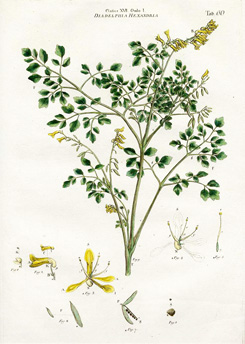Capricious Corydalis
By Audrey Stallsmith

And first the bloodroot-blooms of March
In troops arose; each with its torch
Of hollow snow, within which, bright,
The calyx grottoed golden light.
Hepatica and bluet,
And gold corydalis.
Madison Julius Cawein, “In Solitary Places”
Yellow fumitory is considered a weed in cool and not-too-sunny climates, but I’ve found it difficult to germinate that “weed” in Pennsylvania on purpose! I started trying after I saw a photo of the plant growing on a stone wall in England, with ferny foliage much like that of bleeding heart and spurred tubular yellow flowers.
However, yellow fumitory (Corydalis lutea or Pseudofumaria lutea) seed apparently requires a complicated series of temperature changes to break its dormancy. Corydalis derives from the Greek for “crested lark,” in reference to the blooms’ spurs, and lutea means “yellow.”
Fortunately, the North American rock harlequin (Corydalis sempervirens), which has yellow-tipped pink flowers and a species name meaning “evergreen,” is easier to germinate. I also succeeded with an unidentified pale yellow type which I decided, from the bronze tone of its leaves, might be “fern-leaf” corydalis (Corydalis cheilanthifolia).
Technically biennial, rock harlequin is often grown as an annual, and I can’t now recall whether mine lasted for more than one year. The perennial fern-leafed corydalis did show up off and on—though it was more often off than on. Although certain types of corydalis can flower from late spring to fall in cool climates, they don’t like steamy temperatures and may die back suddenly if the weather heats up. They sometimes return in autumn—and sometimes not!
Strangely enough, I found several specimens of the fern-leafed type growing in a pot near my tropicals one year, far from the flowerbed in which I had originally set the plant. Perhaps I once dug up a less-than-hardy ginger that was growing near the corydalis and accidentally included some seeds in its soil.
I also have fumewort (Corydalis solida), which grows from tubers and produces reddish lavender flowers and lacy foliage as “dense” as its species name. It pops up under a juniper bush near my hellebore plants in April, grows only about 10 inches tall, and—after blooming--disappears as rapidly as it surfaced. If you decide to grow corydalis, you’ll have to adapt to the fact that it is a fly-by-night sort of plant, and its absence doesn’t necessarily mean it is dead.
Most of the 300 or so species prefer rich, fertile, and somewhat gravelly soil in full or partial shade. They won’t tolerate soggy ground in winter, so that soil does need to be very well drained.
Because corydalis can be toxic to horses, make sure yours doesn’t self-sow in a pasture or corral. Although the plants have been used medicinally, most frequently as a tranquilizer or for pain relief, their narcotic qualities make them somewhat toxic to humans as well.
These days, everyone wants the blue-flowered varieties, mostly flexuosa (“zigzag”) types which originated in China and only became widely available recently. I hear they can be tricky to grow also.
That could be due to the fact that corydalis resents transplanting and can sulk for a long time after having its roots disturbed. So it would probably be best to buy small plants which haven’t grown large enough for their roots to reach the edges of their containers.
If you can get fresh seed from a friend, you might want to try scattering it in an appropriate place in the garden. This wilding just may work for you, if allowed to sprout and grow on its own terms!
Corydalis lutea image is from J. S. Mueller's Illustratio Systematis Sexualis Linnaei, courtesy of plantillustrations.org.








